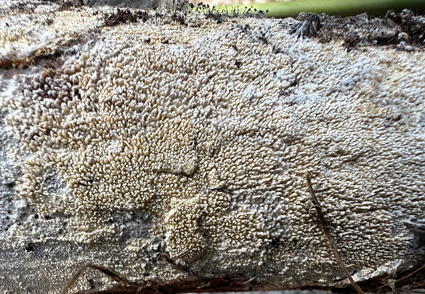Abstract
The species of Sistotremastrum are wood decay fungi, distributed worldwide. During a survey of fungi in mixed forests in Guizhou and Zhejiang Provinces, China, a new species, Sistotremastrum massonianum was described based on morphological characteristics and molecular evidence. Morphologically, this new species is characterized by farinaceous basidioma, grandinoid to odontoid hymenial surface, basidia with four sterigmata and narrowly ellipsoid to broadly cylindrical basidiospores 3.3–4.8 × 2.1–2.8 µm. The two-gene (ITS+nLSU) analysis of the genus Sistotremastrum indicated that S. massonianum represents a significantly supported monophyletic group, which is clustered with S. aculeatum, S. aculeocrepitans, S. denticulatum, and S. geminum.
References
- Anonymous (1969) Flora of British fungi: colour identification chart. Her Majesty’s Stationery Office, London, 6 pp.
- Boidin, J. & Gilles, G. (1994) Contribution à la connaissance des Corticiés à basides urniformes ou suburniformes (Basidiomycotina). Bulletin de la Société Mycologique de France 110: 185–229.
- Chen, J.J. & Dai, Y.C. (2021) Two new species of Physisporinus (Polyporales, Basidiomycota) from Yunnan, Southwest China. Mycological Progress 20: 1–10. https://doi.org/10.1007/s11557-020-01647-8
- Cho, Y., Kim, J.S., Dai, Y.C., Gafforov, Y. & Lim, Y.W. (2021) Taxonomic evaluation of Xylodon (Hymenochaetales, Basidiomycota) in Korea and sequence verification of the corresponding species in GenBank. PeerJ 9: e12625. https://doi.org/10.7717/peerj.12625
- Cui, B.K., Li, H.J., Ji, X., Zhou, J.L., Song, J., Si, J. & Dai, Y.C. (2019) Species diversity, taxonomy and phylogeny of Polyporaceae (Basidiomycota) in China. Fungal diversity 97: 137–392. https://doi.org/10.1007/s13225-019-00427-4
- Dhingra, G., Singh, A., Kaur, J., Priyanka, K., Rani, M., Sood, S., Singla, N., Kaur, H., Jain, N., Gupta, S., Kaur, M., Sharma, J., Kaur, R. & Kaur, G. (2014) A checklist of resupinate, non–poroid agaricomycetous fungi from Himachal Pradesh, India. Synopsis Fungorum 32: 8–37.
- Edler, D., Klein, J., Antonelli, A. & Silvestro, D. (2021) raxmlGUI 2.0: A graphical interface and toolkit for phylogenetic analyses using RAxML. Methods in Ecology and Evolution 12: 373–377. https://doi.org/10.1111/2041-210X.13512
- Eriksson, J. (1958) Studies in the Heterobasidiomycetes and Homobasidiomycetes – Aphyllophorales of Muddus National Park in North Sweden. Symbolae Botanicae Upsalienses 16: 1–172
- Gérald, G. & Alvarado, P. (2021) Sistotremastrum limonadense sp. nov. from French Guiana. Phytotaxa 498 (1): 35–43. https://doi.org/10.11646/phytotaxa.498.1.4
- Gruhn, G., Alvarado, P., Hallenberg, N., Roy, M. & Courtecuisse, R. (2018) Contribution to the taxonomy of Sistotremastrum (Trechisporales, Basidiomycota) and the description of two new species, S. fibrillosum and S. aculeocrepitans. Phytotaxa 379 (1): 27–38. https://doi.org/10.11646/phytotaxa.379.1.2
- Hall, T.A. (1999) BioEdit: A user-friendly biological sequence alignment editor and analysis program for Windows 95/98/NT. Nucleic Acids Symposium Series 41: 95−98.
- Katoh, K., Rozewicki, J. & Yamada, K.D. (2017) MAFFT online service: multiple sequence alignment, interactive sequence choice and visualization. Briefings in Bioinformatics 20: 1160–1166. https://doi.org/10.1093/bib/bbx108
- Larsson, K.H. (2007) Re-thinking the classification of corticioid fungi. Mycological Research 111: 1040–1063. https://doi.org/10.1016/j.mycres.2007.08.001
- Liu, S.L., He, S.H., Wang, X.W., May, T., He, G., Chen, S.L. & Zhou, L.W. (2022a) Trechisporales emended with a segregation of Sistotremastrales ord. nov. (Basidiomycota). Mycosphere 13: 862–954. https://doi.org/10.5943/mycosphere/13/1/11
- Liu, S.L., He, S.H., Liu, D.M. & Zhou, L.W. (2021) Two new species of Fibrodontia (Trechisporales, Basidiomycota) with a key to worldwide species. Journal of Fungi 7 (11): 982. https://doi.org/10.3390/jof7110982
- Liu, S.L., Ma, H.X., He, S.H. & Dai, Y.C. (2019) Four new corticioid species in Trechisporales (Basidiomycota) from East Asia and notes on phylogeny of the order. MycoKeys 48: 97.
- Liu, Z.B., Wu, Y.D., Zhao, H., Lian, Y.P., Wang, Y.R., Wang, C.G., Mao, W.L. & Yuan, Y. (2022b) Outline, divergence times, and phylogenetic analyses of Trechisporales (Agaricomycetes, Basidiomycota). Frontiers in Microbiology 13: 818358. https://doi.org/10.3389/fmicb.2022.818358
- Nylander, J. (2004) MrModeltest V2. program distributed by the author. Bioinformatics 24: 581–583. https://doi.org/10.1093/bioinformatics/btm388
- Pouzar, Z. (1966) Studies in the taxonomy of the polypores 2. Folia Geobotanica et Phytotaxonomica 1: 356–375. https://doi.org/10.1007/BF02854587
- Ronquist, F. & Huelsenbeck, J.P. (2003) MrBayes 3: Bayesian phylogenetic inference under mixed models. Bioinformatics 19: 1572–1574. https://doi.org/10.1093/bioinformatics/btg180
- Spirin, V., Volobuev, S., Viner, I., Miettinen, O., Vlasák, J., Schoutteten, N., Motato-Vásquez ,V., Kotiranta, H., Hernawati & Larsson, K.H. (2021) On Sistotremastrum and similar-looking taxa (Trechisporales, Basidiomycota). Mycological Progress 20: 453–476. https://doi.org/10.1007/s11557-021-01682-z.
- Swofford, D.L. (2002) PAUP*. Phylogenetic Analysis Using Parsimony (*and Other Methods). Version 4.0b10. https://doi.org/10.1111/j.0014-3820.2002.tb00191.x
- Telleria, M.T., Dueñas, M. & Martín, M. (2014) Sistotremastrum chilensis (Trechisporales, Basidiomycota), a new species from Chilean Patagonia. Phytotaxa 158 (1): 93–98. https://doi.org/10.11646/phytotaxa.158.1.7
- Telleria, M.T., Melo, I., Dueñas, M., Salcedo, I., Beltrán-Tejera, E., Rodríguez-Armas, J.L. & Martín, M.P. (2013) Sistotremastrum guttuliferum: a new species from the Macaronesian islands. Mycological Progress 12: 687–692. https://doi.org/10.1007/s11557-012-0876-0
- Thompson, J.D., Gibson, T.J., Plewniak, F., Jeanmougin, F. & Higgins, D.G. (1997) The CLUSTAL_X windows interface: flexible strategies for multiple sequence alignment aided by quality analysis tools. Nucleic Acids Research 25: 4876–4882. https://doi.org/10.1093/nar/25.24.4876
- Vilgalys, R. & Hester, M. (1990) Rapid genetic identification and mapping of enzymatically amplified ribosomal DNA from several Cryptococcus species. Journal of Bacteriology 172: 4238–4246.
- White, T.J., Bruns, T., Lee, S. & Taylor, J. (1990) Amplification and direct sequencing of fungal ribosomal RNA genes for phylogenetics. PCR protocols: a guide to methods applications 18: 315–322.
- Wu, F., Zhou, L.W., Vlasák, J. & Dai, Y.C. (2022) Global diversity and systematics of Hymenochaetaceae with poroid hymenophore. Fungal Diversity 113: 1–192. https://doi.org/10.1007/s13225-021-00496-4
- Zhao, H., Zhou, M., Liu, X.Y., Wu, F. & Dai, Y.C. (2022) Phylogeny, divergence time estimation and biogeography of the genus Onnia (Basidiomycota, Hymenochaetaceae). Frontiers in Microbiology 13: 907961. https://doi.org/10.3389/fmicb.2022.907961


